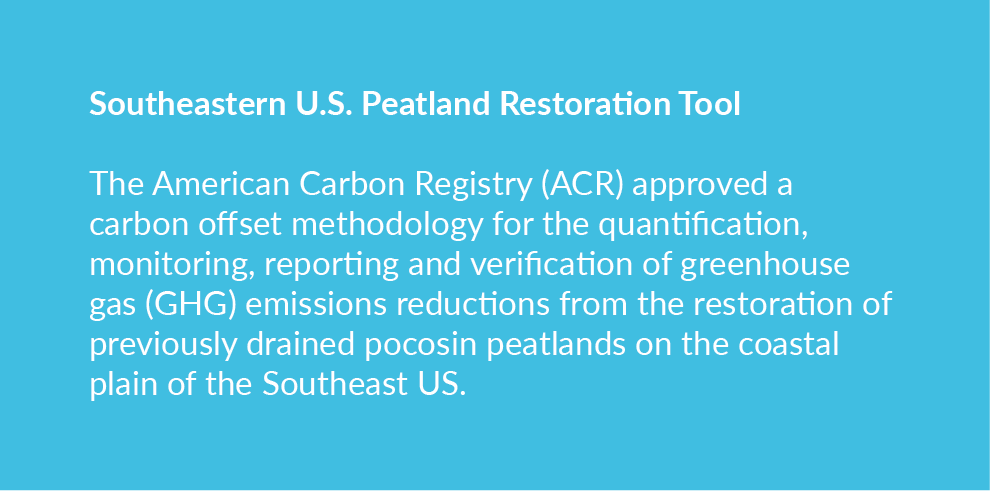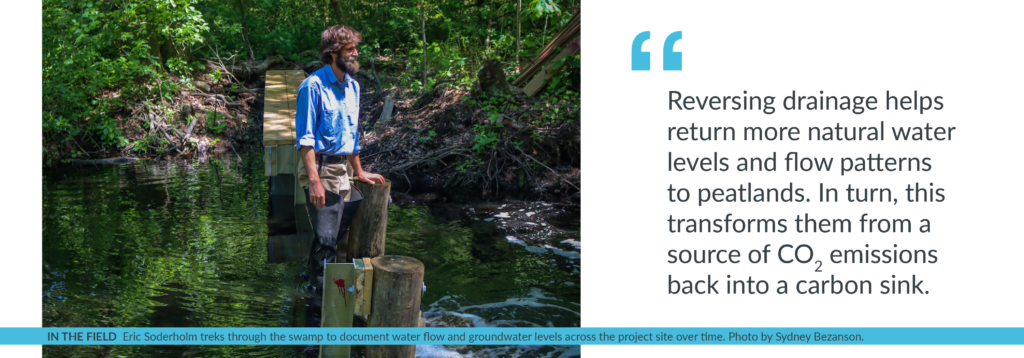Last updated on January 25th, 2024
The Nature Conservancy is restoring the hydrology of peat soils in coastal North Carolina to combat climate change.

The Atlantic coastal plain along the Southeastern United States (SE US) holds powerful potential in its peatlands. These unique wetlands store carbon from waterlogged plant material dating as far back as 10,000 years. But they also capture carbon across their living landscape of forest and shrub communities.
Like many other peatlands across the world, large portions of the network of bogs and swamp forest that once stretched over millions of acres in the SE US have been ditched and drained. Restoring these drained peatlands is proving to be a critical natural climate solution.
“This work is a giant plumbing job of sorts,” says Eric Soderholm, restoration specialist for The Nature Conservancy (TNC) in North Carolina. “Reversing drainage helps return more natural water levels and flow patterns to peatlands. In turn, this transforms them from a source of carbon dioxide emissions back into a carbon sink.”


Peatlands are a type of wetland whose soils contain a high amount of partially decayed organic matter that has accumulated very gradually over thousands of years. They retain an incredible amount of carbon in their ever-growing layer of peat soil. Peatlands cover just 3% of the earth’s surface but store more than twice the carbon as all the world’s forests combined. They span tropical rainforests, permafrost regions and coastal areas.
Approximately 1.2 million acres of peatlands in the Southeastern U.S., and 70% of those found in North Carolina, have been ditched and drained. Drained peatlands emit carbon dioxide. Restored peatlands retain carbon. Think of it this way: 10 acres of natural, undrained peatlands in the Southeast can remove 5.3 passenger vehicles’ emissions in a year. In contrast, 10 acres of drained peatland can add 21.5 passenger vehicles’ emissions. Yet, this comparison does not even consider emissions from peatland wildfires. Due to its rich carbon content, unnaturally dry peatland soils are highly flammable. This makes them vulnerable to more frequent and intense catastrophic wildfires that can burn several feet deep into a peatlands soil and belch huge quantities of carbon dioxide in a single event.
The Nature Conservancy in North Carolina and its partners have been steadily restoring peatlands including portions of the U.S. Fish and Wildlife Service’s Great Dismal Swamp, Pocosin Lakes and Alligator River National Wildlife Refuges. The distinctive peatlands found on the coastal plain from Virginia to Georgia represent many wetland communities that are broadly called “pocosin”, an Algonquin word. Plants here are diverse, yet all share an affinity for soggy soil conditions: pond pine, Atlantic white cedar, swamp tupelo, cypress, loblolly bay, inkberry, fetterbush, canebrake, pitcher plants, cranberry, sphagnum moss. If you grab a handful of pocosin peatland soil, half of what you are holding is carbon.


TNC developed this one-of-a-kind carbon methodology with TerraCarbon, a carbon offset project and natural climate solutions advisory firm. The methodology has been put into practice at a 1,241-acre proof-of-concept restoration site within Pocosin Lake National Wildlife Refuge, in partnership with the US Fish and Wildlife Service. Much of the peatland that remains drained in the SE US is privately owned. This tool allows landowners to register new projects with the American Carbon Registry to generate and sell verified carbon credits on the voluntary carbon market based on the emission reductions achieved by a peatland rewetting project. Income from the sale of verified carbon credits can help cover upfront restoration costs required to successfully rewet and monitor drained peatlands.
Eric Soderholm leads TNC’s work to restore peatlands in North Carolina, partnering with state and federal agencies to restore degraded peat soils by installing water control structures and other water management infrastructure throughout each project site.

On his days monitoring TNCs most recent restoration project within Great Dismal, Soderholm treks through the swamp to document water flow and groundwater levels across the project site over time. “It is fascinating to watch water return to the peatland,” says Eric Soderholm. “Once we know how water moves and fluctuates, Refuge staff can use this information to adjust that water flow to maximize both the habitat and flood resilience enhancements restoration provides.”

When peat soils are rewetted, they are much less flammable and create conditions for more diverse and resilient wetland forest communities to thrive. Since peat soils also have the great potential to sequester carbon when saturated with groundwater, restoring more natural water patterns in peatland is a natural climate solution. Most recent conservative estimates from the Duke University Wetlands Center suggest that if the remaining drained peatlands in the SE US were restored, emission reductions of at least 2.66 million metric tons of carbon dioxide could be achieved every year.

Once the “plumbing” is right at a peatland restoration site, rewetted conditions allow the re-establishment of peatland specialist native plants such as Atlantic white cedar. Cedar-dominated forests, which are now a globally threatened community, thrive in peaty, moist soil of swamps and bogs. Peatlands also support a variety of wildlife. Many songbirds, such as the prothonotary warbler, seek refuge there in spring. In the summer, black bear forage and enjoy the extra sun.

People also benefit. Improvements on Refuge lands help slow down and absorb storm water before it reaches a farming community just downslope from restoration sites, potentially reducing damage to crops and property.
Likewise, restoring peatlands vastly reduces the risks to human health and community safety associated with the numerous catastrophic peat wildfires this region has recently endured. A study following North Carolina’s 41,000-acre Evans Road peatland fire in 2008 determined that emergency room visits for cardiopulmonary complications increased significantly in the counties exposed to its toxic peat smoke.
Pocosin peatlands naturally sequester nitrogen and mercury which leach from drained sites at much higher rates. Restored sites with water control infrastructure help to reduce the quantity of these contaminants entering our rivers and sounds, both of which can impact aquatic communities and commercial fisheries.

TNC initially focused its partnership efforts to restore peatlands at sites on federal lands across the coastal plain. The organization is now moving south to state lands managed by the North Carolina Wildlife Resource Commission at Angola Bay Game Land. There are still large swathes of peat to be restored from Virginia to Georgia. TNC’s implementation work and partnership with researchers has helped lay the groundwork for that restoration. One of the next most critical steps is to expand restoration progress to the significant acreage of privately-owned drained SE US peatlands.
Interest from carbon project developers to work with private peatland landowners has continued to grow since the release of the ACR carbon offset methodology. Layering carbon finance with both existing and emerging state, federal and other funding sources is beginning to create the incentive needed for landowners to pursue the many benefits peatland restoration projects can yield.
“We’ve worked diligently with our partners to get the plumbing right at many sites in Northeastern North Carolina,” says Eric Soderholm. “This work has helped to demonstrate what can be accomplished elsewhere.”

Why are peatlands being degraded or destroyed?
European settlers gradually drained peatlands along the coastal plain at first to reach high value timber for human settlement and export and for agricultural conversion. Technological advances in modern excavation equipment fueled a boom in the 20th century to convert peatlands to agriculture, pine plantation and experiment with mining peat as a fuel source. However, significant acreage that was previously drained and logged are no longer in any active productive use yet continue to experience the negative impacts from historic ditch networks. Developmental pressures continues to loom for some of these special natural areas.
Why does peat burn?
Peat is highly flammable when dried. When wildfires occur in degraded, dry areas, they have devastating impacts on the land, as they can continue to smolder for long periods of time. Their emissions can also affect human health.
How can landowners get involved?
Landowners can access the peatland restoration methodology through the American Carbon Registry.
